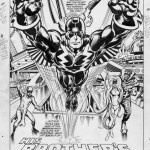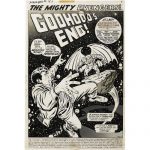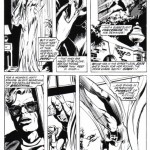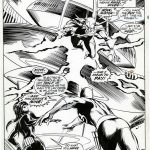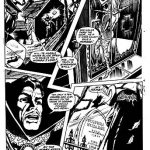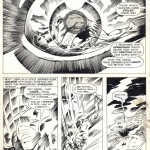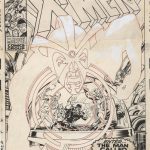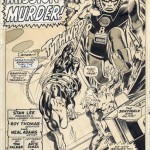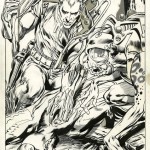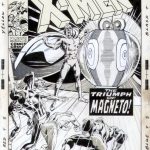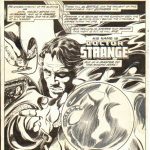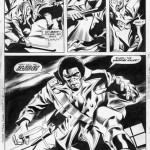MAD MEN: Though he is renowned as one of the most accomplished, award-winning comic-book inkers ever, Tom Palmer, Sr. (born July 13, 1942) began his career as a Madison Avenue advertising man. After high school, Palmer held a brief, entry level “gopher” position at a large advertising agency next to Grand Central Station, near Madison Avenue in Manhattan. Palmer was at the agency just long enough to learn a bit about production art. He soon started taking art school classes at night under the legendary illustrator Frank Reilly (who had studied under the famous George Bridgman and Dean Cornwell). While still a teenager, Palmer left his employee position at the ad agency to be a freelance illustrator, answering an ad in the Sunday New York Times placed by a small commercial art studio, a few blocks up Madison Avenue on 40th Street. The hectic little advertising art studio was looking for a freelance board artist. Here, Palmer was mentored by former EC and romance comics artist Jack Kamen, with whom Palmer worked side-by-side. Their meeting was fortuitous; along with their desire to paint illustrations for editorial and advertising clients, they both also loved comics art.
FROM WALLY WOOD TO DR. STRANGE: In 1967, when the Frank J. Reilly School of Art disbanded due to Reilly’s passing, Kamen helped Palmer break into comics by calling his legendary EC Comics associate, Wallace Wood. Like many in the industry, Palmer’s first comics work was assisting Wood. After helping out a bit at the master’s studio, Wood referred Palmer to Mike Esposito, who was working with Ross Andru. After Palmer had helped him on some backgrounds, Esposito referred Palmer to Sol Brodsky at Marvel. Palmer debuted at Marvel pencilling a 22-page tale in Doctor Strange #171 (August, 1968) which was inked by another Wood Studio alumni, Dan Adkins. (Adkins had been drawing the feature prior to it expanding from 10 pages per issue in Strange Tales.) After that, the legendary Gene Colan took over penciling Dr. Strange with Palmer on inks. It was a match made in comic-book heaven. Colan’s moody, tonal pencil renderings left a lot to be translated into ink and Palmer rose to the occasion — in many regards, like no other. Palmer quickly developed a unique combination of pen and brushwork — lines, strokes and textures, which he further augmented with a healthy dose of Zip-a-Tone shading film.
FROM GENE COLAN TO NEAL ADAMS: Following the now-legendary Colan-Palmer run on Dr. Strange, another penciler arrived at Marvel with a very unique approach: Neal Adams. Adams’s line was very different from mainstream superhero comics of the time. He too had a background in advertising art. Prior to his Ben Casey newspaper strip and comic-book work, Neal was at the Johnstone & Cushing Studio where legendary comics talents like Lou Fine and Stan Drake produced top quality advertising and editorial illustration work. Out of all the great inkers at Marvel, including Joe Sinnott, Frank Giacoia and Adkins, Marvel made the best possible decision in assigning Palmer to ink Adams; first on Uncanny X-Men and then on The Avengers. Regarding inking Adams, Palmer said in Comic Book Artist #3, “Other guys today try to pencil as if they were going to ink it, or they’re trying to set it up for the inker. Neal penciled for pencilling; the inking became another art that you brought to it. And I think that’s what I was challenged by. He didn’t put a line down that you just filled in. You didn’t trace it — you had to bring something to it.”
FROM THE 1970S TO THE NEW MILLENNIUM: Between the Dr. Strange work with Colan and the X-Men and Avengers work with Adams, Palmer had proven that the previously, little-known art of comic-book inking was a fine art to be savored and studied. Palmer’s extensive work for Marvel Comics continued, most notably with Gene Colan, on Daredevil (1971–1973), and especially Tomb of Dracula (1973–1979); with John Buscema on the The Avengers (1985–1996); Star Wars (1981–1985); and the entire run of John Byrne’s X-Men: The Hidden Years (1999-2001).
STAR WARS, INKING AND BEYOND: In his 2010 “Silver Age Sage” interview online, Palmer, who was still doing non-comics commercial art assignments, said, “I always continued to work in comics because they were a great source of enjoyment and satisfaction; I found them to be an oasis when the stressful demands of advertising work got to you.” Palmer also continued to paint. In comics, he sometimes pencilled or finished pencils over layouts, as was the case on much of his Avengers work with Buscema. Another golden period for Palmer was his long run on Star Wars. George Lucas personally requested Al Williamson to illustrate the popular franchise’s newspaper strip and Carmine Infantino to pencil the Star Wars comic-book. Right toward the end of Infantino’s long run (after Williamson’s Return of the Jedi movie adaptation and Walt Simonson took over pencilling the comic book), Palmer began inking Star Wars. Though it was on again, off-again for a bit, Palmer developed a great look for Star Wars that was a perfect balance between the comic-book stylizations of Infantino and Simonson and the adventure newspaper-strip realism of Williamson — while being pure Palmer. He started doing more and more of the art himself, including cover art — sometimes fully painted! Palmer’s run on Star Wars is both a high point for that famous property and the perfect example of the artist’s breadth and versatility.
Tom Palmer is not just an inker’s inker and a consummate professional, he is also an artist’s artist deserving of every applicable accolade.
About the author: J. David Spurlock is an artist; author; comics creator; award-winning art historian; creator rights advocate; Director, The Wallace Wood Estate; Agent Emeritus for Julius Schwartz; Agent Emeritus for Carmine Infantino; Co-Founder, Wallace Wood Scholarship Fund; Co-Founder, Steranko Spirit of America Fund; School of Visual Arts NYC Graphic Arts Professor Emeritus; Co-founder, Comics Creators for Holocaust Education; University of Texas Graphic Arts Professor Emeritus; President Emeritus, Society of Illustrators — Dallas; Wyman Institute Arts & Letters Council; Inkwell Awards Ambassador; and Founder of Vanguard Publishing.
(Special thanks to Mike Pascale for providing the files above)

